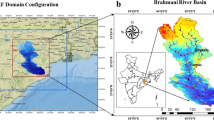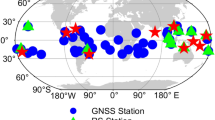Summary
The system of physical equations describing temperature changes near the ground in fog-free air as well as in radiation fog is solved numerically. The variation of the exchange coefficient with height is taken into account using different models while time variations are still disregarded. Temperature changes due to latent heat effects are incorporated in this study. Moreover, the presence of radiative flux divergence is included in an approximate manner.
The solution of the problem is presented in terms of graphs showing the development of temperature and water droplet profiles as function of time and height. Computed liquid water content as well as temperature profiles are in general agreement with observations while the vertical growth of fog usually proceeds too rapidly. Concrete suggestions are given of how to improve the model.
Similar content being viewed by others
References
A. C. Best,Drop-size distribution in cloud and fog, Quart. J. Royal Meteor. Soc.77 (1951), 418.
D. Brunt,Physical and Dynamical Meteorology (Cambridge 1934), 428 pp.
B. Carnahan, H. A. Luther, andJ. O. Wilkes,Preliminary Edition of Applied Numerical Methods, Vol. II (John Wiley and Sons, New York, N.Y. 1964).
E. M. Feigel'son,Light and heat radiation in stratus clouds, translated from Russian, U.S. Dept. of Commerce, Clearinghouse for Federal Scientific and Technical Information, TT 66-51014 (1964).
E. L. Fisher andP. Caplan,An experiment in numerical prediction of fog and stratus, J. Atmos. Sci.20, 5 (1963), 425–437.
H. Kraus,Untersuchungen über den nächtlichen Energietransport und Energieaushalt in der bodennahen Luftschicht bei der Bildung von Strahlungsnebeln, Ber. Dtsch. Wetterd. Nr. 48 (1958).
J. E. MacDonald,The saturation adjustment in numerical modelling of fog, J. Atmos. Sci.20, 5 (1963), 476–478.
H. Philipps,Die nächtliche Abkühlung des Erdbodens durch Strahlung und Wärmeleitung und der Bodenschicht durch Turbulenz, Gerlands Beiträge zur Geophysik56 (1940), 296–319.
B. Rodhe,The effect of turbulence on fog formation, Tellus XIV (1962), 49–86.
W. G. Zdunkowski andF. G. Johnson,Infrared flux divergence calculations with newly constructed radiation tables, J. Appl. Meteor.4, 3 (1965), 371–377.
Author information
Authors and Affiliations
Rights and permissions
About this article
Cite this article
Zdunkowski, W.G., Nielsen, B.C. A preliminary prediction analysis of radiation fog. PAGEOPH 75, 278–299 (1969). https://doi.org/10.1007/BF00875062
Received:
Issue Date:
DOI: https://doi.org/10.1007/BF00875062




